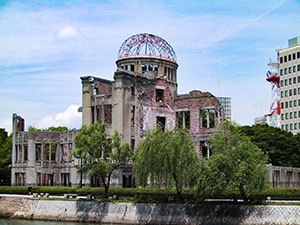
The Hiroshima Prefectural Commercial Exhibition Hall was constructed
in 1915 as a base for promoting the sale of goods produced in Hiroshima
Prefecture. The building designed by Czech architect Jan Letzel was highly
regarded for its imposing, European-style design. Its name changed to Hiroshima
Prefectural Products Exhibition Hall and then to Hiroshima Prefectural Industrial
Promotion Hall. Intensification of the war led the government to discontinue
commercial uses of the Industrial Promotion Hall in March 1944. Instead,
it housed the branch office of the Chugoku Shikoku Public Works Office of
the Internal Affairs Agency and the offices of the Hiroshima District Lumber
and Japan Lumber Control Corporation.
When the atomic bomb exploded, it ravaged the building instantly. Heat blazing
from above consumed the entire building, killing everyone in it. Because
the blast attacked the building from virtually straight overhead, some walls
escaped total collapse. Along with the wire framework of the dome, these
form the shape that has become a symbol. At some point it became known as
the "A-bomb Dome."
In 1966, Hiroshima City determined to preserve the A-bomb Dome indefinitely
and solicited funds from within Japan and overseas. To date, the A-bomb
Dome has undergone three preservation projects.
As a historical witness that conveys the disaster of the first atomic bombing
in history, and as a symbol of the vow to pursue the abolition of nuclear
weapons and enduring peace, in December 1996 the A-bomb Dome was registered
on the UNESCO World Heritage List based on the Convention for the Protection
of the World Cultural and Natural Heritage.